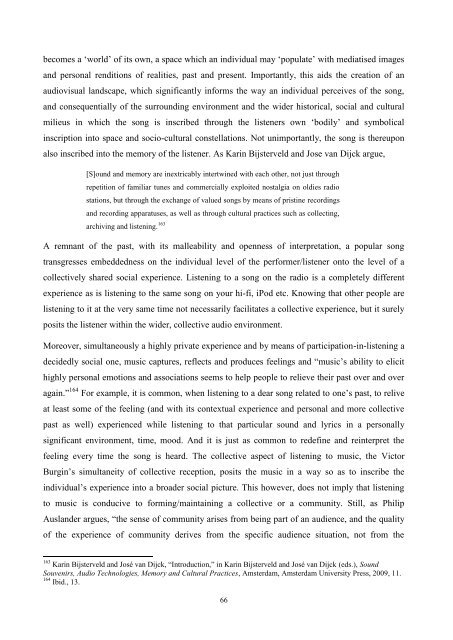UNIVERSITY OF NOVA GORICA GRADUATE SCHOOL ...
UNIVERSITY OF NOVA GORICA GRADUATE SCHOOL ...
UNIVERSITY OF NOVA GORICA GRADUATE SCHOOL ...
Create successful ePaper yourself
Turn your PDF publications into a flip-book with our unique Google optimized e-Paper software.
ecomes a ‗world‘ of its own, a space which an individual may ‗populate‘ with mediatised images<br />
and personal renditions of realities, past and present. Importantly, this aids the creation of an<br />
audiovisual landscape, which significantly informs the way an individual perceives of the song,<br />
and consequentially of the surrounding environment and the wider historical, social and cultural<br />
milieus in which the song is inscribed through the listeners own ‗bodily‘ and symbolical<br />
inscription into space and socio-cultural constellations. Not unimportantly, the song is thereupon<br />
also inscribed into the memory of the listener. As Karin Bijsterveld and Jose van Dijck argue,<br />
[S]ound and memory are inextricably intertwined with each other, not just through<br />
repetition of familiar tunes and commercially exploited nostalgia on oldies radio<br />
stations, but through the exchange of valued songs by means of pristine recordings<br />
and recording apparatuses, as well as through cultural practices such as collecting,<br />
archiving and listening. 163<br />
A remnant of the past, with its malleability and openness of interpretation, a popular song<br />
transgresses embeddedness on the individual level of the performer/listener onto the level of a<br />
collectively shared social experience. Listening to a song on the radio is a completely different<br />
experience as is listening to the same song on your hi-fi, iPod etc. Knowing that other people are<br />
listening to it at the very same time not necessarily facilitates a collective experience, but it surely<br />
posits the listener within the wider, collective audio environment.<br />
Moreover, simultaneously a highly private experience and by means of participation-in-listening a<br />
decidedly social one, music captures, reflects and produces feelings and ―music‘s ability to elicit<br />
highly personal emotions and associations seems to help people to relieve their past over and over<br />
again.‖ 164 For example, it is common, when listening to a dear song related to one‘s past, to relive<br />
at least some of the feeling (and with its contextual experience and personal and more collective<br />
past as well) experienced while listening to that particular sound and lyrics in a personally<br />
significant environment, time, mood. And it is just as common to redefine and reinterpret the<br />
feeling every time the song is heard. The collective aspect of listening to music, the Victor<br />
Burgin‘s simultaneity of collective reception, posits the music in a way so as to inscribe the<br />
individual‘s experience into a broader social picture. This however, does not imply that listening<br />
to music is conducive to forming/maintaining a collective or a community. Still, as Philip<br />
Auslander argues, ―the sense of community arises from being part of an audience, and the quality<br />
of the experience of community derives from the specific audience situation, not from the<br />
163 Karin Bijsterveld and José van Dijck, ―Introduction,‖ in Karin Bijsterveld and José van Dijck (eds.), Sound<br />
Souvenirs, Audio Technologies, Memory and Cultural Practices, Amsterdam, Amsterdam University Press, 2009, 11.<br />
164 Ibid., 13.<br />
66

















